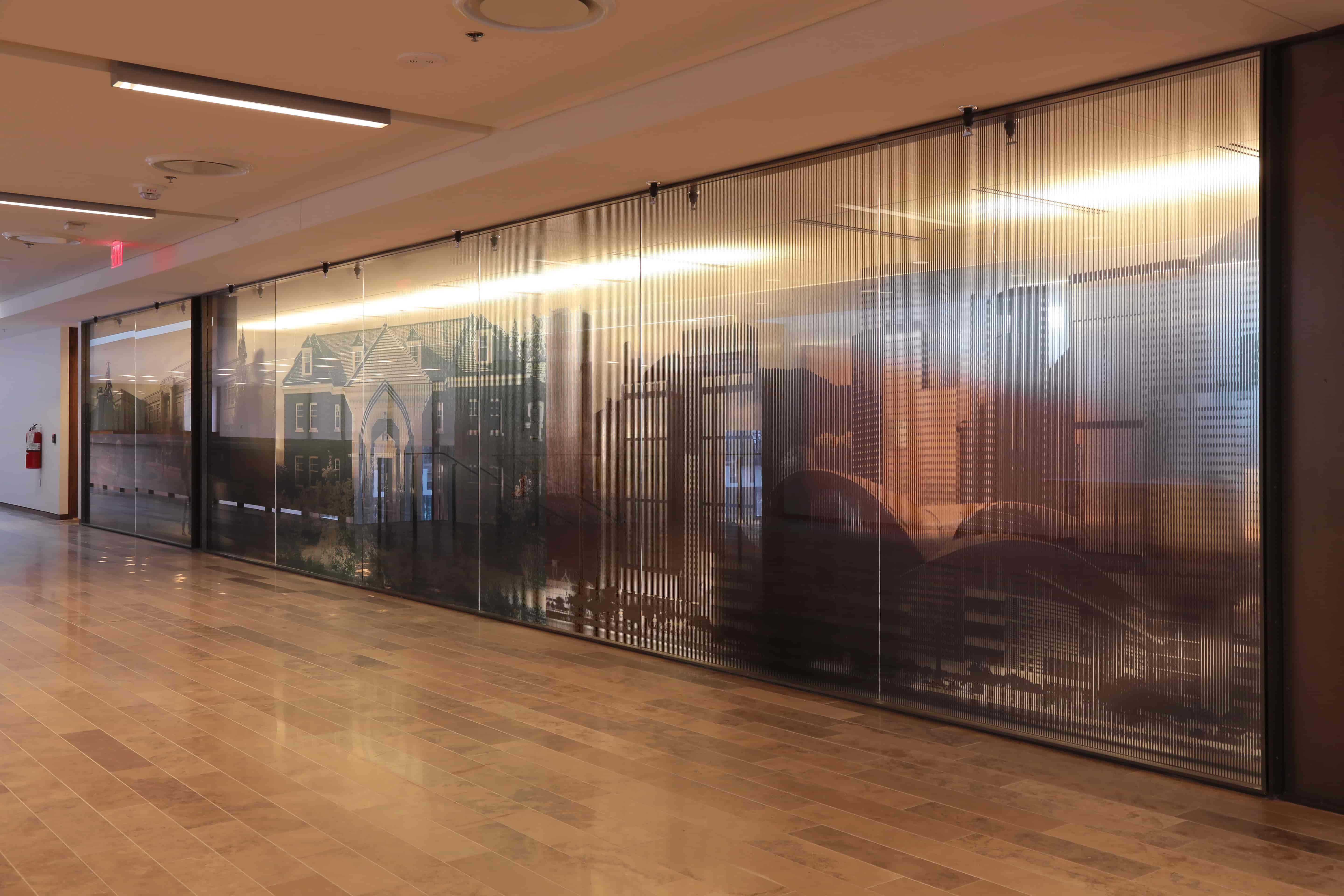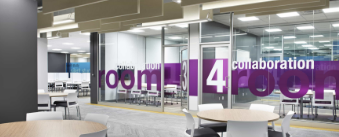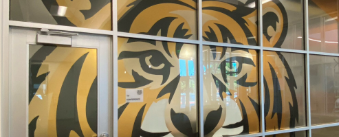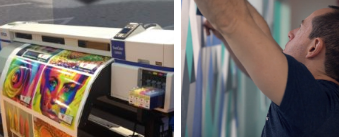
Your building window design has a profound impact on day-to-day occupant experience, curb appeal, and brand identity. Among other things, thoughtful use of glass elements in commercial architecture will:
- Support mental and physical well being inside the structure
- Ensure energy efficiency
- Turn heads from the street
Proper window placement matters, as does effective size and shape. However, the biggest step you can take to accomplish these goals is to evaluate the traits of the window glass itself. World-class architectural window designs will need the right finish and treatments — functional, decorative, subtle, bold, and everything in between.
Here’s what you need to know to design stunning windows for your next commercial architecture project.
Table of Contents:
- Why Focus on Window Design in Commercial Architecture?
- Selecting & Positioning Your Commercial Windows
- Architectural Window Design Ideas
- How to Turn Heads With Commercial Window Graphics
- Choosing the Right Film Material Finish
- LINTEC Digital Window Graphics
Why Focus on Window Design in Commercial Architecture?
A lot goes into the design of a commercial structure — it would be easy to relegate windows to an afterthought. However, research has shown that window design can impact cognitive function, health, sleep, and productivity of those in the building. To make sure these impacts are positive, you’ll want windows that:
- Maximize natural light deep into the structure’s interior
- Help control thermal performance of the building
- Support mood with pleasing aesthetics and glare reduction
- Create the right balance of openness and privacy
Strategic window placement is a big part of these goals. Facility Executive advocates for a commercial window design that provides “continuous access to views (ideally of nature) and regulates light levels to ensure employees enjoy thermal comfort throughout the day.” You’ll want windows to allow as much sunlight as possible into the structure, but you can’t neglect the impact of heat, glare, or what’s visible through the window on occupant comfort.
Windows are actually the most significant influence on how a building is seen and interacted with by the inside and outside world.
Selecting & Positioning Your Commercial Windows
Large structures frequently feature walls nearly made of windows in today’s glass-centric commercial architecture. However, the materials, treatments, and positioning of exterior and interior glass features will be critical decision points even in a glass-facade structure.
Window Styles
- Bow and Bay Windows: These windows physically project outward from the facade of the structure for aesthetic reasons and wide viewing areas. They’re ideal for window locations with attractive outside views.
- Picture Windows: A large picture window is meant to maximize natural sunlight, but it does not open. Use these in large, deep, or potentially dark interior areas (in stairwells or rooms with vaulted ceilings, for instance).
- Casement Windows: Commercial architecture relies heavily on these hinged-style windows that open in a fashion similar to doors. They’re ideal for ventilation and ease of use.
- Sliding Windows: A sliding design provides a wider view than a casement type window, and will be ideal for commercial architecture of observation areas or shops.
Frame Material
- Wood: Commercial architecture will generally steer clear of entirely wood framing, an antiquated but classic frame material for windows. Fully wood frames generally do not insulate as well as metal or vinyl frames. With that said, totally wood framing may be useful in historical structures (or those with a historical feel) or buildings that rely on natural elements for a “green” atmosphere.
- Metal: Metal framing, commonly aluminum, is durable and sturdy. It can accept weather resistant paints, too. Metal frames often include a wood interior frame, with the metal frame protecting the exterior.
- Vinyl: The lightweight and virtually maintenance-free vinyl frames of today come in many colors — and they’re cost-efficient. They’re weather impervious, but not quite as durable as metal.
Window Glass
- Clear Glass: Transparent, optically clear glass shows off products and allows people outside the structure to see the interior area clearly. This works best for shops and businesses that want to display products or create a bright and welcoming ambiance.
- Frosted or Tinted Glass: Reflective, frosted, or tinted treatments or window privacy films can ensure greater privacy inside the structure while still allowing in natural light. Medical or financial offices, spas, and hospitality-focused buildings often opt for this sort of glass. Frosted treatments also open up creative options for etching, cutouts, branding, and eye-catching optical illusions with the right dynamic films.
- Security Glass: The internal or external laminate on security glass prevents it from shattering into loose shards — a break would instead produce a “spiderweb” effect. While pricier than traditional glass, this is a safe choie for storefronts and other areas where security and injury prevention are critical.
- Tempered Glass: Another popular commercial window material, tempered glass is four times stronger than regular glass and highly heat resistant. It crumbles into small crystallized bits when broken, which are not as dangerous as the razor-sharp shards of a traditional glass pane. This is preffered for aquariums, glass doors, and is often seen in factory spaces.
Window Location
- Composition: A balanced composition is important and aesthetically pleasing, but this doesn’t necessarily mean you need a symmetrical design. An asymmetrical design can create visual interest and a unique building identity.
- Daylighting: Taller windows will maximize light penetration. In general, a window lights an interior space to a depth roughly 1.5 times the head height of the window. Skylights and clerestory windows can increase the effective daylighting of your commercial architecture. Light wells and windowed courtyards can allow for bi-directional lighting.
- Direction: Be careful of the glare created on east and west facing facades due to rising and setting of the sun — glare will cause occupants to close curtains or pull down shades. Tinting and other measures are appropriate here. North and south facing windows offer more neutral daylight throughout the day.
- Sill Height: Lower sills allow for additional daylight (but not much). More importantly, they’ll enable fuller views of the area below the window from inside the structure — and vice versa. Use a lower sill height when the view is desirable. Higher-positioned windows are one way to protect the privacy of the interior environment.
Architectural Window Design Ideas
Blend Interior and Exterior Space
An effortless transition between inside and outside space takes commercial architecture design to the next level. Your windows play an important role in the seamless transition from one location to another. Decorative metal panels around or over your windows, for instance, can carry textures and material identities from the inside to the outside of the building while remaining visible from both sides.
Use Glass to Support “Broken-Plan” Space
The open office has dominated commercial architecture for years, but the price in terms of privacy and comfort are now well documented. You can reduce distracting ambient noise, the “fishbowl effect” and a warehouse feel with decorative interior windows and glass partitions. Use these elements to supportconceptual boundaries in a “broken-plan” space — a concept that has trended in residential architecture in recent years.
Window Film Makes Glass More Versatile
One of the simplest and most cost-effective ways to customize your commercial window design is with decorative window film. Use these tinted, frosted, or optically clear treatments to combine form and function with:
- Glare reduction
- Scratch resistance & safety
- Light/heat regulation
- UV filtration
- Privacy
- Branding
- Color identity & style
How to Turn Heads With Commercial Window Graphics
Finishing touches take a two-dimensional blueprint and transform it into a fully realized, aesthetically pleasing three-dimensional space. Commercial window design might start with placement and glass selection, but that’s just the tip of the iceberg. Decorative window graphics can elevate a traditional design into something dynamic, exciting, and also full of practical benefits.
Here are a few ideas to inspire your creativity with a unique application of commercial window graphics.
Vivid Branding
The best commercial windows help your building to tell a story and establish a visual identity for your brand. This can be accomplished with frosted, tinted, or textured window graphics — or even with high-definition laser-printed images. Use these decorative films to promote your brand with logos, on-brand messaging, and branded colors. Plain glass can take on an etched, sandblasted, or patterned look that communicates an aspect of your brand (Upscale? Creative? Welcoming? Trustworthy?) with subtle visual cues.
Lifestyle imagery is another great approach for combining visual interest, a brand-supporting ambiance, and a resonant company culture. Decorate windows with vivid images of people or places that you’d like passersby and employees to associate with your brand.
Expanding the Space
Sheet windows and glass walls give you extra opportunities compared to traditional walls or partitions in your commercial architecture design. Windows naturally give the impression that a room has more square footage than it really does.
Decorative window graphics can take this phenomenon one step further. Consider the illusion of vast space a window would create when it looks like a breathtaking mountain landscape, waterfall, exotic garden, or a cerulean sky dotted with clouds. When you invite the outdoors into your interior design, you expand the space in imaginative and dynamic ways.
Controlled Daylighting
Natural light is a primary motivator for your commercial window design. However, distracting glare, heat buildup, and UV rays can compromise the benefits of sunlight. Commercial window graphics offer several ways to mitigate these issues without eliminating the benefits of natural light.
Strike a balance between light and comfort with attractive and sweeping graphics, frosted or blurred films, light-reducing tints, and other film treatments. It’s possible to create a “dappled” sunlight effect by interrupting the sun with die-cut shapes and designs in frosted or colored film or with cutout graphics and logos. Use negative space to create cutout images in a frosted window for even more gentle light.
Improved Privacy
A glass-heavy design can help a commercial structure feel larger and more open, but it may also cause people to feel overexposed and watched, which “[threatens] people’s engagement and their cognitive, emotional and even physical wellbeing” — something we call the fishbowl effect. Frosted, tinted, or printed films and graphics can keep a space illuminated from the outside without sacrificing valuable privacy.
Use printed decorative graphics to break up the space with imagery, signage, or abstract designs and improve the sense of privacy — even when they do not fully block vision through the window glass. In areas where more privacy is advantageous, a frosted or patterned film can act as a buffer layer between areas that expresses creativity and style while still allowing natural light to pass through.
Visual Impact & Exciting Illusions
Windows are an ideal medium for blending the interior and exterior of your commercial architecture project. As a layer that attracts the eye from both sides, you can use decorative window graphics to harmonize interior and exterior colors and styles, carrying the surrounding landscape or your brand identity into either realm.
Window graphics and films are versatile and cost-effective, making them ideal for completing your architectural vision and finishing a space with a spark of creativity and visual appeal. They can even be used to create clever or artistic optical illusions with cutout space or dynamic commercial window films. The possibilities are limited only to the imagination of the architect or designer.
Choosing the Right Film Material Finish
The appearance of your decorative window graphics and films matters, but so do the qualities of the finish. You’ll have a lot of choices, depending on your needs:
- Scratch Resistant Glass Finishes
- Optically Clear Glass Finishes
- Permanent and Semi-Permanent Glass Finishes
- UV Blocking Glass Finishes
- Non-PVC Glass Finishes
There are also satin finishes available for times when a glossy graphic may create unwanted shine or reflection. Satin finished graphics retain their vibrancy at all times of day and in nearly any lighting conditions, keeping blacks as close to their original forms as possible for stark contrast and vibrancy.
Sometimes, when displaying a window graphic on a wall, window, or other architectural objects, the shininess of glossy graphics may not be wanted. This is where Protect Satin graphics come into play. They not only have a high coat weight adhesive that wraps around the relief height of UV Ink Jet prints, but they also have an aesthetically appealing non-glossy, satin finish.
LINTEC Digital Window Graphics
At LINTEC of America, our digital window graphics are designed to create an environment that’s uniquely yours. Windows will connect your building occupants to the outside world. We provide options that will not only wow onlookers, but offer you:
- Customizable Window Film Designs
- Easy Installation and Removability
- Scratch Resistance
- Stunning Clarity
AIA members love digital window graphics for the powerful impact they have on a design’s environmental profile and aesthetics. Browse our portfolio to get more new and exciting ideas on how you can improve your commercial architecture with dynamic, practical, and vivid custom graphics. Feel free to connect with our team for more information on the possibilities!




